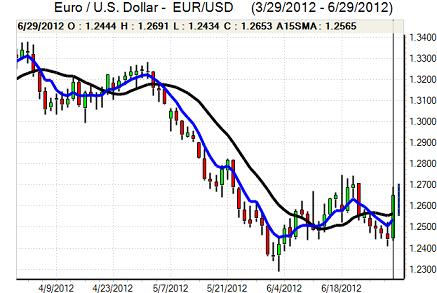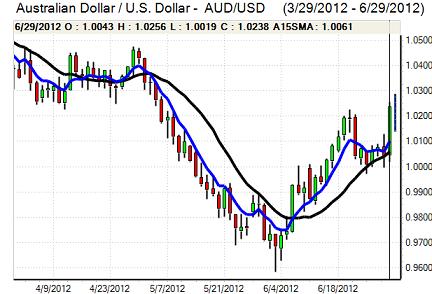EUR/USD
The Euro initially consolidated in the 1.26 region in Europe on Friday before moving sharply higher during the New York session. There was a sharp decline in Spanish and Italian bond yields as spreads over German bonds also narrowed sharply. There was optimism that the potential for ESM funds to be supplied directly to the banking sector would help improve underlying conditions.
The German parliament eventually agreed to ratify the ESM and fiscal compact as political tensions intensified. There were still very important doubts surrounding the political deal to support Italy and Spain, especially as there are still substantial details to be worked out and there will be the threat of substantial delays. German Finance Ministry officials were looking to contain the political concessions as domestic opposition increased. There have further protests surrounding the ESM to the Constitutional Court which is liable to delay ratification and could force much heavier political supervision. In this context, economic and political doubts surrounding the peripheral economies are liable to return very quickly.
The Euro-zone headline inflation rate was unchanged at 2.4% for June which will maintain expectations of a further decline in the inflation rate over the next few months which will increase grounds for an ECB rate cut on economic grounds.
The latest US data releases did not have a major impact, especially as they were nor first-tier releases. Personal spending was unchanged for May with only a slight increase in income which will continue to limit the scope for spending growth. Following a sharp decline last month, the Chicago PMI index only moved marginally higher to 52.9 from 52.7 while the University of Michigan consumer confidence index also dipped lower and underlying confidence in the US growth outlook will remain subdued.
Market positioning was very important with a squeeze on short Euro positions, especially as it was the last trading day for the second quarter. In this environment, the Euro pushed to highs near 1.27 before retreating during the Asian session on Monday as underlying fears persisted. The latest IMM data continued to show a near-record level of short Euro positions.

Source: VantagePoint Intermarket Analysis Software
Call now and you will be provided with FREE recent forecasts
that are up to 86% accurate* 800-732-5407
If you would rather have the recent forecasts sent to you, please go here
Yen
After an initial peak near 79.75, the dollar edged weaker during the European session on Friday before rallying to a peak near 80 as underlying risk appetite improved.
The headline Japanese Tankan index was slightly stronger than expected with a gain to -1 for the latest quarter from -4 previously with the non-manufacturing sector index also edging higher. There will still be concerns surrounding the regional growth outlook with the Chinese PMI index remaining generally weak.
There was an increase in exporter selling as the dollar neared the 80 level and it edged back towards 75.75 during the Asian session on Monday.
Sterling
Sterling found support on dips to below 1.58 against the dollar on Friday and pushed sharply higher to a peak close to 1.57 as wider US losses dominated the markets and Sterling held its ground against the Euro.
The Bank of England remained uneasy over the financial sector in its latest financial stability report and there will be further concerns surrounding the banks. There will also be concerns that the Libor fixing row will maintain pressure for increased banking-sector regulation which may also have an impact in curbing already limited lending and stifle growth.
The Bank of England will remain an important focus ahead of this week’s policy meeting amid expectations that there will be a further expansion of quantitative easing. In this context, the latest PMI manufacturing data will also be watched very closely on Monday as a further slide would increase pressure on the central bank. There was some increased speculation that additional quantitative easing would not have a major currency impact in damaging Sterling and losses were contained in Asia on Monday.
Swiss franc
The dollar initially stabilised near 0.9550 against the franc on Monday before retreating and testing support below 0.95. The Euro initially made some headway against the Swiss currency with a peak above the 1.2030 level, but it was unable to sustain the gains and retreated back to the familiar 1.2010 region in Asia on Monday.
National Bank Chairman Jordan continued to back the Euro minimum level, but there will be concerns over the Euro’s inability to hold brief gains, especially as there has been an increase in Euro-zone political tensions which will tend to maintain defensive capital flows into the Swiss currency.

Source: VantagePoint Intermarket Analysis Software
Call now and you will be provided with FREE recent forecasts
that are up to 86% accurate* 800-732-5407
If you would rather have the recent forecasts sent to you, please go here
Australian dollar
The Australian dollar found support on dips towards the 1.0160 region against the US currency on Friday and pushed higher in New York with a peak above 1.0260 as risk appetite generally improved.
Domestically, there was an improvement in the latest PMI manufacturing index for June, although it remained below the 50 level. There will be caution ahead of the Reserve Bank’s Tuesday policy meeting and a decision to leave rates on hold would provide some net support for the Australian currency with risk conditions also continuing to have an important impact.



